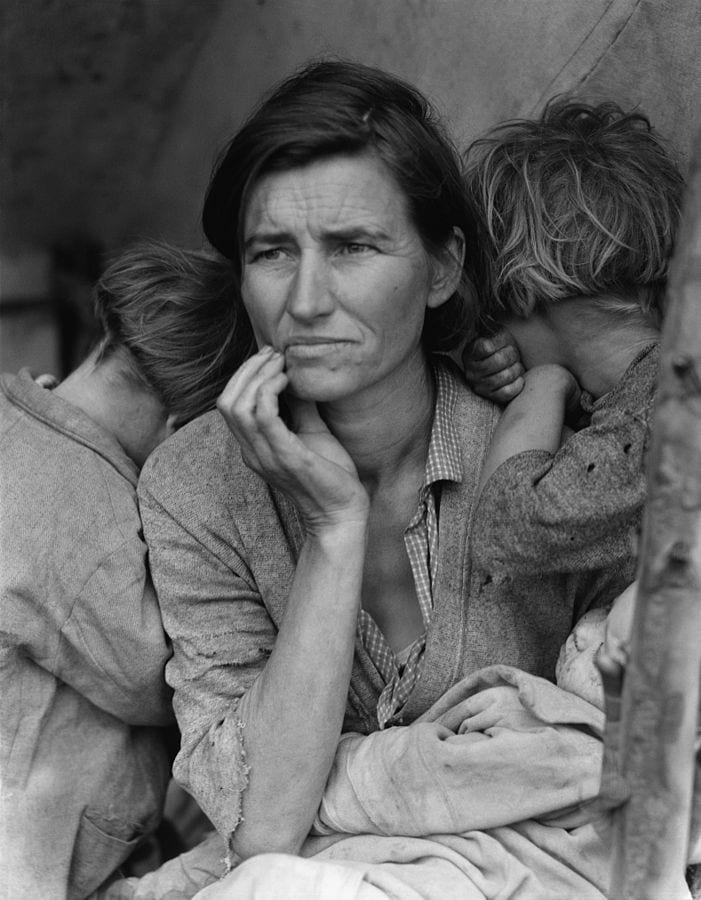Migration: it will be up to the next generation to change the picture
By Blog Editor, IOE Digital, on 8 May 2017
Kathryn Riley.
There is a photograph called ‘Migrant Mother’. It is an arresting black and white shot. The woman is centre stage and gazes sideways on. She is beyond exhaustion: every line etched in her face tells its own story.

At first glance, she appears to have two children. Look more closely and you will see she has three: a child asleep on her lap and two other children, faces averted from the camera, hair cropped, revealing their fragile necks.
I was startled to discover that this iconic photograph was taken in 1936. The image could have been yesterday – in Aleppo; in a refugee camp in Greece; on a packed, rickety boat scuttling across the Mediterranean. The photograph, part of a collection owned by Elton John, has recently been on display at The Tate Modern. The photographer – Dorothea Lange – was trying to capture the human cost of the American Depression. She later recounted her experience of taking that photograph:[1]
I saw and approached the hungry and desperate mother, as if drawn by a magnet… She told me her age, that she was thirty-two. She said that they had been living on frozen vegetables from the surrounding fields, and birds that the children killed.
‘Every few hundred years throughout history’, Peter Drucker wrote some time ago, a sharp ‘transformation’ occurs. ‘In a matter of decades, society altogether rearranges itself. Fifty years later a new world exists. And the people born into it cannot imagine the world in which their grandparents lived and into which their own parents were born.’
Today’s world – in which more than half the world’s refugees are children – seems to be at one of those points of transformation: and it is the children and young people in our schools who will shape the new world order. This is why schools need to be places of belonging. ‘Belonging’ is that sense of being somewhere where you can be confident that you will fit in and safe in your identity.
While schools may not be able to protect today’s ‘Migrant Mother’, in a volatile global context – in which new ideas can as easily be built on quicksand as on solid foundations – schools are important conduits of information and one of the few shared social institutions which can create a sense of belonging for the young people who pass through their gates. Schools are ever-changing kaleidoscopes of people, ideas and attitudes which have the potential to coalesce around shared beliefs and understandings. Through creating that sense of belonging, schools can help young people recognise that what seems a ‘given’ today can change tomorrow, and that tomorrow belongs to them.
Photo by Lange, Dorothea(w), photographer. [Public domain], via Wikimedia Commons
[1] From: Popular Photography, Feb. 1960.
3 Responses to “Migration: it will be up to the next generation to change the picture”
- 1
-
2
Karen Seashore wrote on 10 May 2017:
The Dorthea Lange photo is iconic in the American experience as a reflection of the reality of “the other America” in the 1930s. It continues to evoke similar responses in today’s youth. As we create new categories of “the other” today, it is critical, as Riley points out, that we remember the children as well as the exhausted mother. In the U.S., all immigrants (whether they have entered legally or not) have a right to public education. What happens to them–how they are treated and included or excluded–is up to educators. Building relationships that will enhance belonging is at the heart of this work.
-
3
Kathryn Riley wrote on 11 May 2017:
Dear Reader
Thanks for your post. I do appreciate the differences between migrants, refugees and asylum seekers. However, as Karen Seashore writes from the States, the Dorothea Lange picture (which was taken in 1936 and is called ‘Migrant Mother’) gives a message to all of us today. It’s about encouraging children to be compassionate, and working to make schools places of belonging. I see this as a humanitarian response, not a political one.
Best wishes
Kathryn
 Close
Close




The author of this piece seems to be unaware of the fact that teachers are not allowed to push their personal political views onto children and neither can schools.
Migrants, refugees and asylum seekers are not the same thing and conflating them is irresponsible. As someone who volunteers for a refugee charity, it’s clear to me that this conflation is part of the problem we currently have.
There are some (as in this blog) who take the worst case scenario of a refugee or asylum seeker and exaggerates to suggest this is indicative of the situation of migrants (some of whom are wealthy and simply desire to be here – want rather than need). At the other extreme, there are those who take the best care scenario migrant (someone who has options and choices, wants rather than needs to come to the UK) and apply it to the refugees and asylum seekers.
Adults should be able to debate issues openly in our society, make their arguments, listen to others and refine/develop these in light of the evidence and facts. Schools should replicate this. It is not incumbent upon schools to promote the values of educationalists who lack understanding of the topic, are unable to make an articulate argument on the issue but nevertheless want their personal political views to be accepted more widely in society.